Abstract
A significant proportion of patients with presenile dementia due to primary cerebral atrophy do not have Alzheimer's disease. One form of non-Alzheimer dementia may be designated as dementia of frontal lobe type (DFT), on the basis of a characteristic neuropsychological picture suggestive of frontal lobe disorder, confirmed by findings on single photon emission tomography. The case histories of seven patients exemplify the disorder: a presentation of social misconduct and personality change, unconcern and disinhibition, in the presence of physical well-being and few neurological signs. Assessment revealed economic and concrete speech with verbal stereotypes, variable memory impairment, and marked abnormalities on tasks sensitive to frontal lobe function. Visuo-spatial disorder was invariably absent. Comparisons of DFT and Alzheimer patients revealed qualitative differences in clinical presentation, neurological signs, profile of psychological disability, electroencephalography, single photon emission tomography and demography. DFT, which may represent forms of Pick's disease, may be more common than is often recognised.
Full text
PDF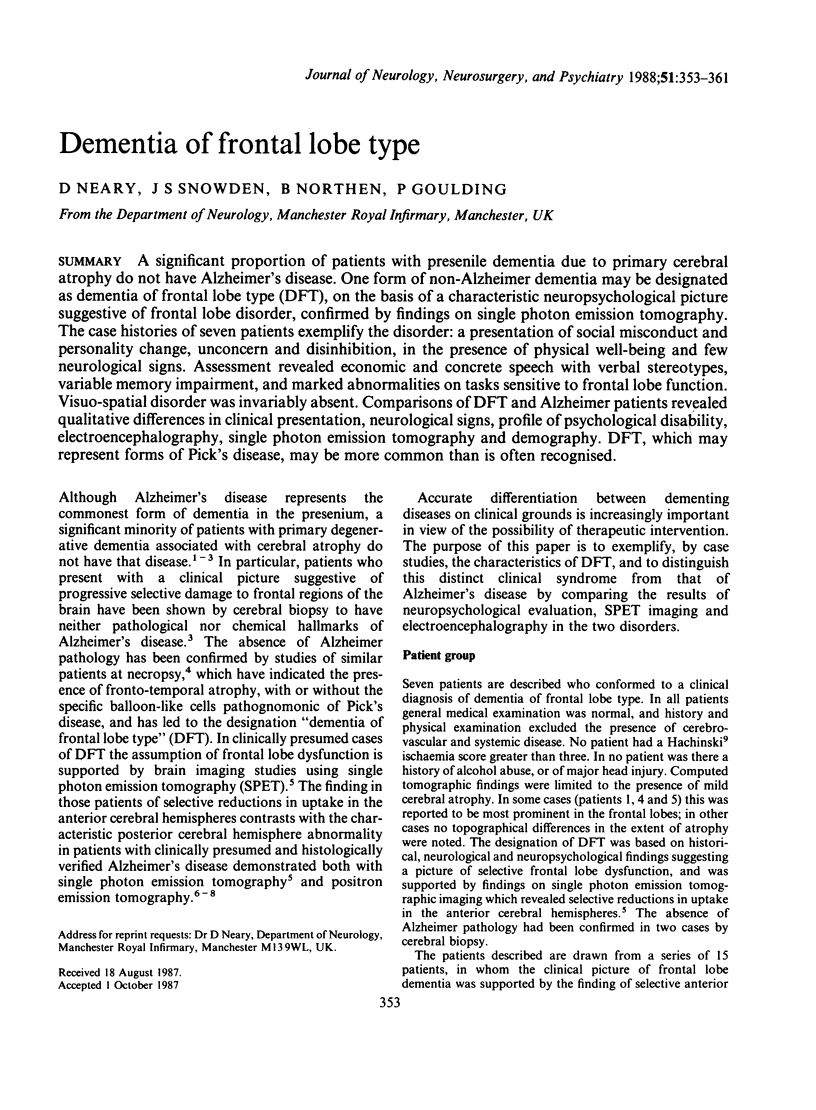
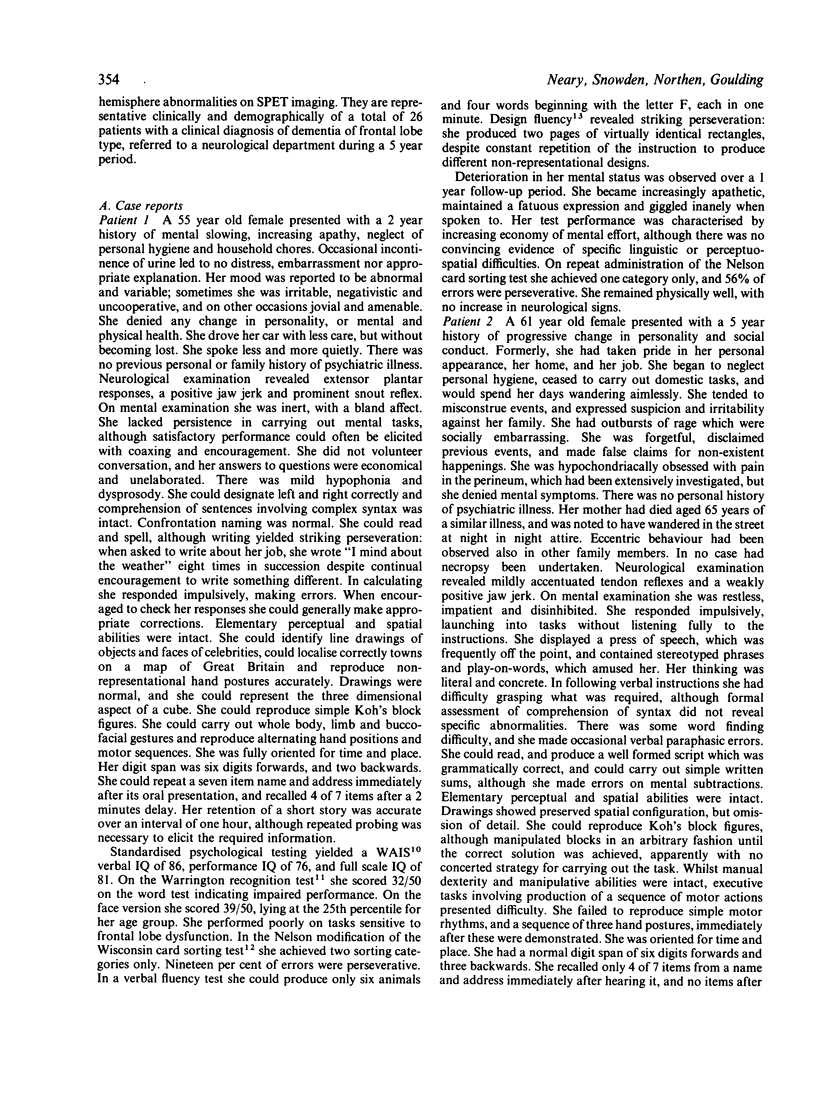
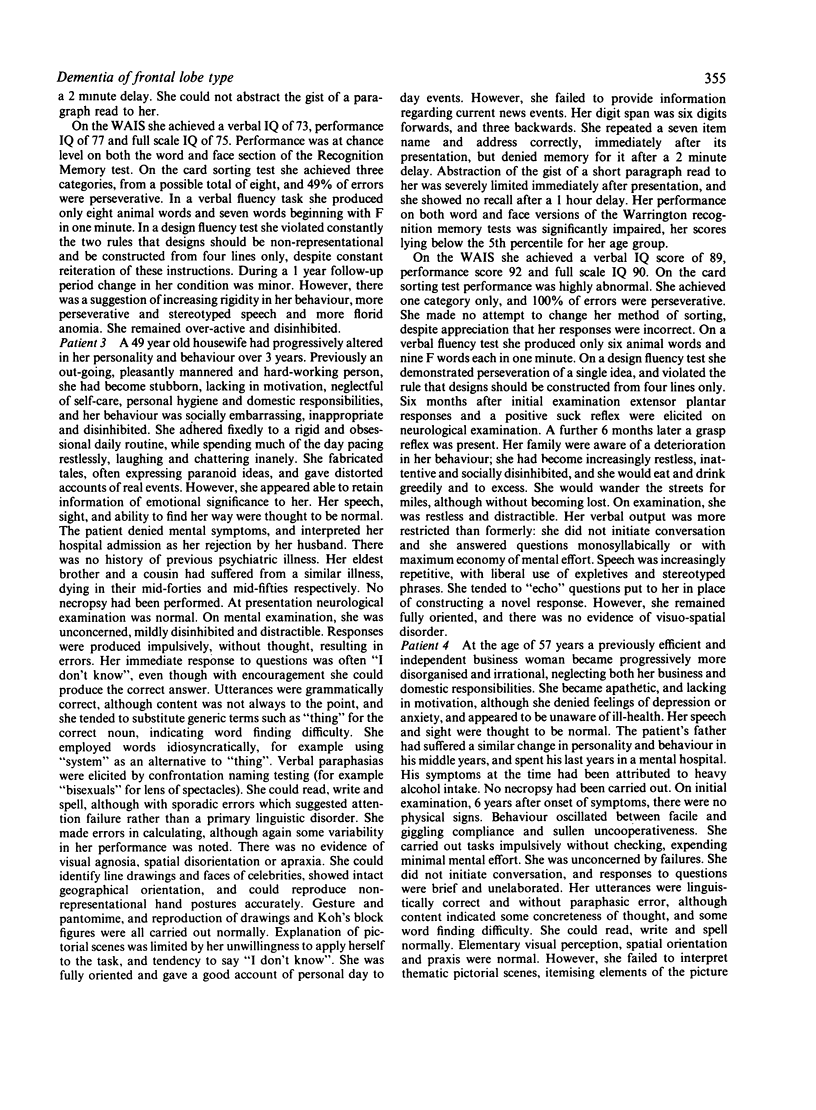
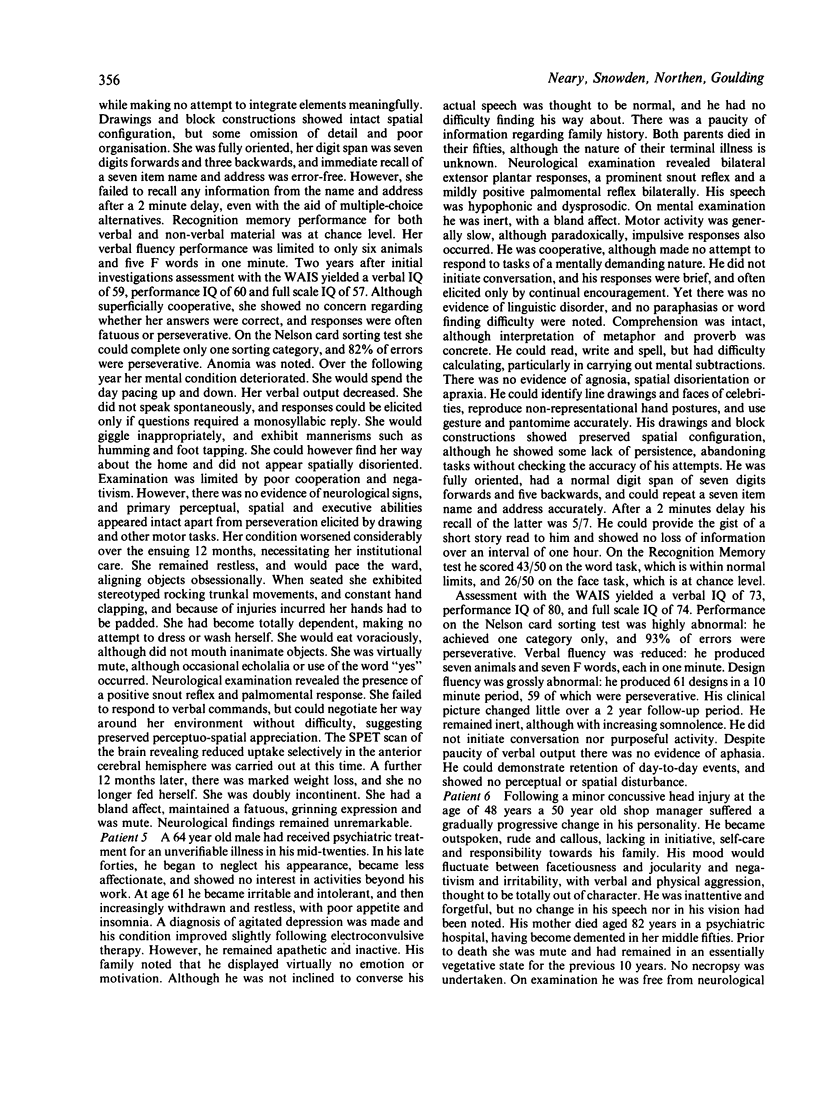
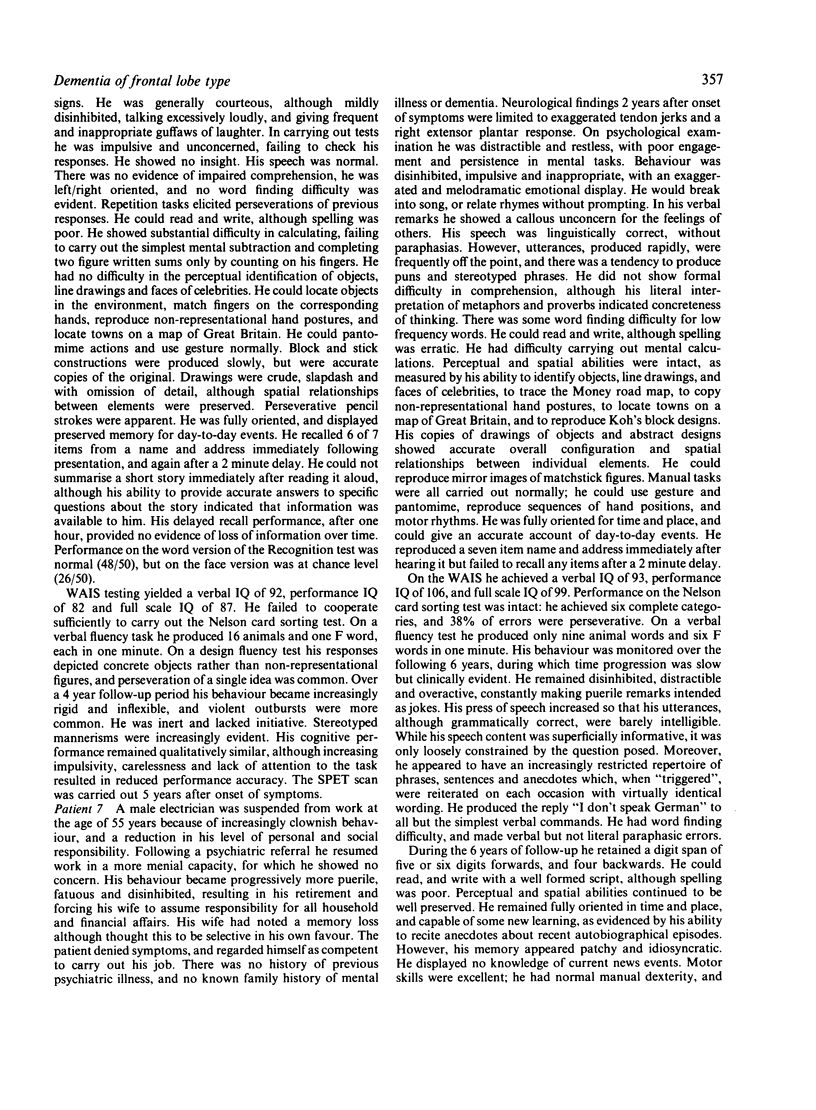

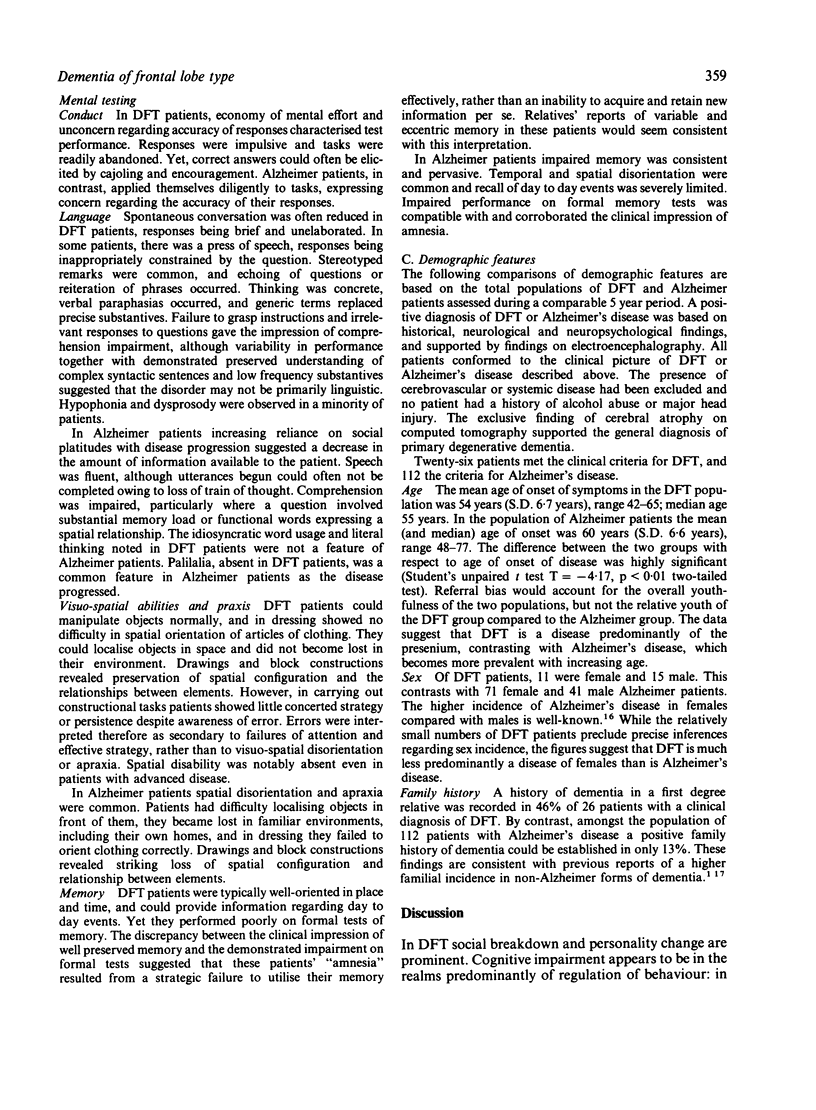

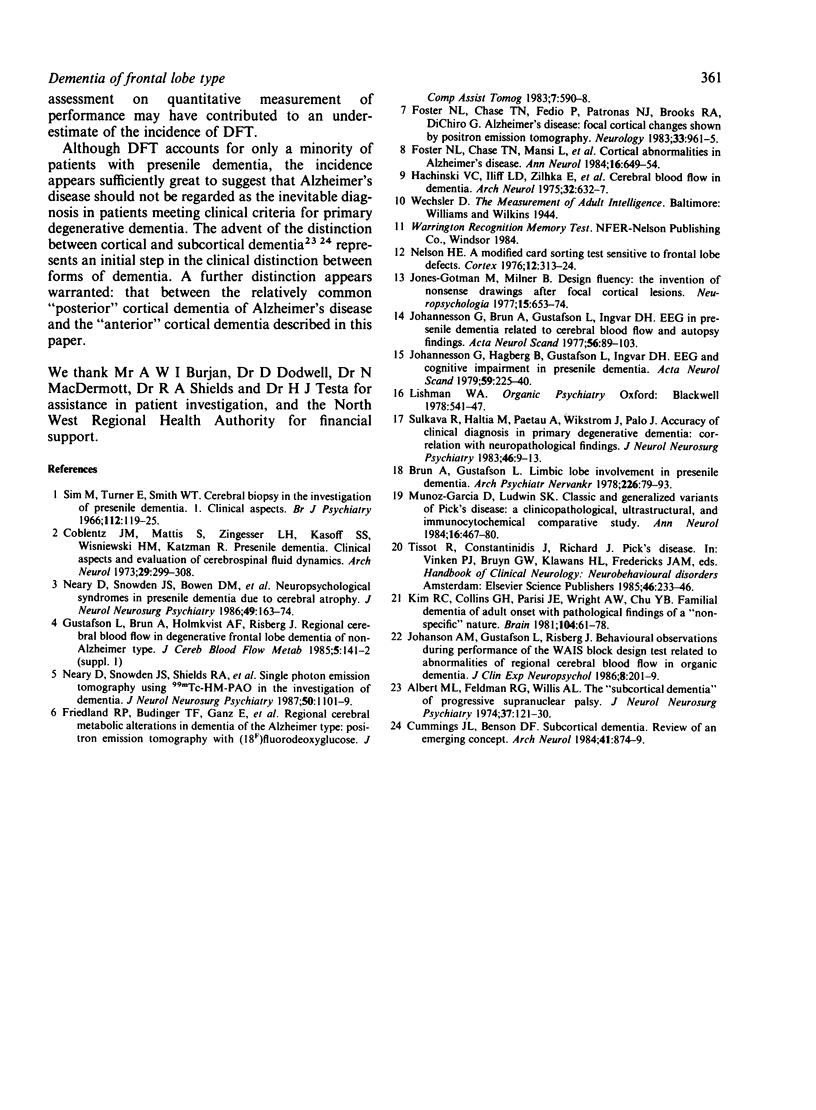
Selected References
These references are in PubMed. This may not be the complete list of references from this article.
- Albert M. L., Feldman R. G., Willis A. L. The 'subcortical dementia' of progressive supranuclear palsy. J Neurol Neurosurg Psychiatry. 1974 Feb;37(2):121–130. doi: 10.1136/jnnp.37.2.121. [DOI] [PMC free article] [PubMed] [Google Scholar]
- Brun A., Gustafson L. Limbic lobe involvement in presenile dementia. Arch Psychiatr Nervenkr (1970) 1978 Nov 14;226(2):79–93. doi: 10.1007/BF00345945. [DOI] [PubMed] [Google Scholar]
- Coblentz J. M., Mattis S., Zingesser L. H., Kasoff S. S., Wiśniewski H. M., Katzman R. Presenile dementia. Clinical aspects and evaluation of cerebrospinal fluid dynamics. Arch Neurol. 1973 Nov;29(5):299–308. doi: 10.1001/archneur.1973.00490290039003. [DOI] [PubMed] [Google Scholar]
- Cummings J. L., Benson D. F. Subcortical dementia. Review of an emerging concept. Arch Neurol. 1984 Aug;41(8):874–879. doi: 10.1001/archneur.1984.04050190080019. [DOI] [PubMed] [Google Scholar]
- Foster N. L., Chase T. N., Fedio P., Patronas N. J., Brooks R. A., Di Chiro G. Alzheimer's disease: focal cortical changes shown by positron emission tomography. Neurology. 1983 Aug;33(8):961–965. doi: 10.1212/wnl.33.8.961. [DOI] [PubMed] [Google Scholar]
- Foster N. L., Chase T. N., Mansi L., Brooks R., Fedio P., Patronas N. J., Di Chiro G. Cortical abnormalities in Alzheimer's disease. Ann Neurol. 1984 Dec;16(6):649–654. doi: 10.1002/ana.410160605. [DOI] [PubMed] [Google Scholar]
- Hachinski V. C., Iliff L. D., Zilhka E., Du Boulay G. H., McAllister V. L., Marshall J., Russell R. W., Symon L. Cerebral blood flow in dementia. Arch Neurol. 1975 Sep;32(9):632–637. doi: 10.1001/archneur.1975.00490510088009. [DOI] [PubMed] [Google Scholar]
- Johannesson G., Hagberg B., Gustafson L., Ingvar D. H. EEG and cognitive impairment in presenile dementia. Acta Neurol Scand. 1979 May;59(5):225–240. doi: 10.1111/j.1600-0404.1979.tb02933.x. [DOI] [PubMed] [Google Scholar]
- Johanson A. M., Gustafson L., Risberg J. Behavioral observations during performance of the WAIS Block Design Test related to abnormalities of regional cerebral blood flow in organic dementia. J Clin Exp Neuropsychol. 1986 Jun;8(3):201–209. doi: 10.1080/01688638608401312. [DOI] [PubMed] [Google Scholar]
- Jones-Gotman M., Milner B. Design fluency: the invention of nonsense drawings after focal cortical lesions. Neuropsychologia. 1977;15(4-5):653–674. doi: 10.1016/0028-3932(77)90070-7. [DOI] [PubMed] [Google Scholar]
- Jóhannesson G., Brun A., Gustafson I., Ingvar D. H. EEG in presenile dementia related to cerebral blood flow and autopsy findings. Acta Neurol Scand. 1977 Aug;56(2):89–103. doi: 10.1111/j.1600-0404.1977.tb01414.x. [DOI] [PubMed] [Google Scholar]
- Kim R. C., Collins G. H., Parisi J. E., Wright A. W., Chu Y. B. Familial dementia of adult onset with pathological findings of a 'non-specific' nature. Brain. 1981 Mar;104(Pt 1):61–78. doi: 10.1093/brain/104.1.61. [DOI] [PubMed] [Google Scholar]
- Munoz-Garcia D., Ludwin S. K. Classic and generalized variants of Pick's disease: a clinicopathological, ultrastructural, and immunocytochemical comparative study. Ann Neurol. 1984 Oct;16(4):467–480. doi: 10.1002/ana.410160408. [DOI] [PubMed] [Google Scholar]
- Neary D., Snowden J. S., Bowen D. M., Sims N. R., Mann D. M., Benton J. S., Northen B., Yates P. O., Davison A. N. Neuropsychological syndromes in presenile dementia due to cerebral atrophy. J Neurol Neurosurg Psychiatry. 1986 Feb;49(2):163–174. doi: 10.1136/jnnp.49.2.163. [DOI] [PMC free article] [PubMed] [Google Scholar]
- Neary D., Snowden J. S., Shields R. A., Burjan A. W., Northen B., MacDermott N., Prescott M. C., Testa H. J. Single photon emission tomography using 99mTc-HM-PAO in the investigation of dementia. J Neurol Neurosurg Psychiatry. 1987 Sep;50(9):1101–1109. doi: 10.1136/jnnp.50.9.1101. [DOI] [PMC free article] [PubMed] [Google Scholar]
- Nelson H. E. A modified card sorting test sensitive to frontal lobe defects. Cortex. 1976 Dec;12(4):313–324. doi: 10.1016/s0010-9452(76)80035-4. [DOI] [PubMed] [Google Scholar]
- Rodger T. F. The role of the psychiatrist. Br J Psychiatry. 1966 Jan;112(482):1–8. [PubMed] [Google Scholar]
- Sulkava R., Haltia M., Paetau A., Wikström J., Palo J. Accuracy of clinical diagnosis in primary degenerative dementia: correlation with neuropathological findings. J Neurol Neurosurg Psychiatry. 1983 Jan;46(1):9–13. doi: 10.1136/jnnp.46.1.9. [DOI] [PMC free article] [PubMed] [Google Scholar]


